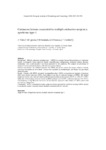Cutaneous lesions associated to multiple endocrine neoplasia syndrome type 1

Ver/Abrir
Use este enlace para citar
http://hdl.handle.net/2183/20703Colecciones
- Investigación (FCS) [1293]
Metadatos
Mostrar el registro completo del ítemTítulo
Cutaneous lesions associated to multiple endocrine neoplasia syndrome type 1Fecha
2008Cita bibliográfica
Vidal A, Iglesias MJ, Fernández B, Fonseca E, Cordido F. Cutaneous lesions associated to multiple endocrine neoplasia syndrome type 1. J Eur Acad Dermatol Venereol. 2008;22(7):835-838
Resumen
[Abstract]
Background Multiple endocrine neoplasia type 1 (MEN1) is a genetic disease that predisposes to endocrine tumour development. Some cutaneous lesions (angiofibromas, collagenomas, melanosis guttaca, lipomas, melanomas, ‘cafe au lait macules’) have been associated to this syndrome. We compare the prevalence of cutaneous lesion in affected patients with their non‐carrier relatives.
Patients and method We studied 9 patients with MEN1 and 20 non‐carrier, first‐degree relatives. Genetic screening was realized in all of them. Patients were examined by dermatologist, and biopsy was performed when necessary.
Results Patients with MEN1 presented hyperparathyroidism (100%), neuroendocrine tumours of pancreas (66%) and pituitary adenomas (44%); their relatives were free of endocrine features of MEN1. The studied cutaneous lesions were more prevalent in affected patients than in non‐carriers (55.5% vs. 25%; P = 0.029). Odds ratio of developing cutaneous lesions in MEN1 patients was 6.6 (95% confidence interval, 1.09–40.43). The frequency of angiofibromas was lower (22.2%) than the reported in other studies (43–88%), and we did not find any collagenoma.
Conclusions MEN1 is associated to some cutaneous lesions and could be useful for detecting MEN1 carriers in an affected family. Cutaneous lesions should be assessed in MEN1 patients.
Palabras clave
Angiofibroma
Collagenoma
Lipoma
Multiple endocrine neoplasia type 1
Collagenoma
Lipoma
Multiple endocrine neoplasia type 1
Descripción
Original article
Versión del editor
Derechos
This is the peer reviewed version of the article which has been published in final form at Wiley Online Library. This article may be used for non-commercial purposes in accordance with Wiley Terms and Conditions for self-archiving.
ISSN
1468-3083
0926-9959
0926-9959





